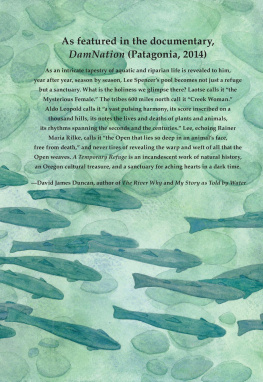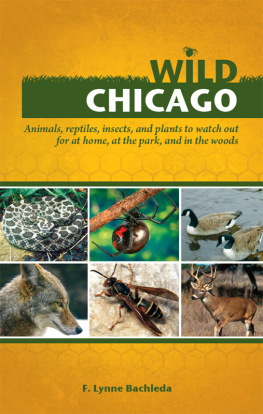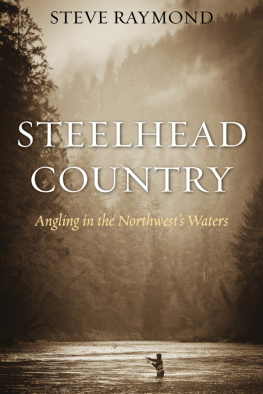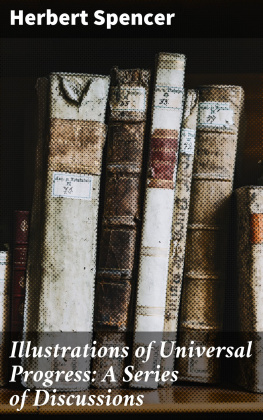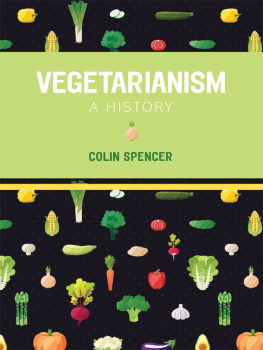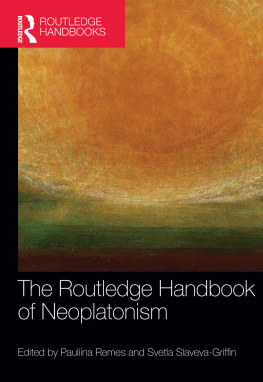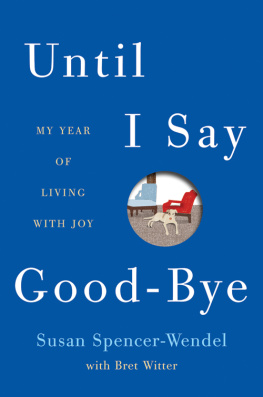
A Temporary Refuge:
Fourteen Seasons with Wild Summer Steelhead
At Patagonia, we publish a collection of books that reflect our pursuits and our
valuesbooks on wilderness, outdoor sports, innovation, and a commitment to
environmental activism.
Copyright 2017 Patagonia Works
Text Lee Spencer
All rights reserved. No part of this book may be used or reproduced in any manner
whatsoever without written permission from publisher and copyright holders.
Requests should be emailed to or mailed to Patagonia
Books, Patagonia Inc., 259 W. Santa Clara St., Ventura, CA 93001-2717.
FIRST EDITION
Printed in Canada on 100% post-consumer waste recycled paper.

Editors: John Paine & John Dutton
Book Designer: Jeff Batzli
Illustrations: Cathy Eliot
Project Manager: Jennifer Patrick
Production: Rafael Dunn
Director of Books: Karla Olson
Hardcover ISBN 978-1-938340-67-3
E-Book ISBN 978-1-938340-68-0
Library of Congress Control Number 2017902209

Dedicated to my good dog Sis
and to my late good friend Carroll Kirk
and the dog of his youth, Dash.


Colossal though they may be,
stars and galaxies rank low on
the scale of complexity.
That is why it isnt presumptuous
to aspire to understand them.
A frog poses a more daunting scientific
challenge than a star.
Martin Rees, 1997
Before the Beginning, Our Universe and Others
FOREWORD

THE NATURAL HISTORY OF A SPECIAL PLACE
THOSE OF US WHO CHOSE conservation as a career did so because we were influenced by one or more books by authors such as Aldo Leopold, Rachel Carson, John Muir, and Roderick Haig-Brown. The book that set my career on a conservation path was Aldo Leopolds A Sand County Almanacthe early version without the Round River essays. I was eighteen when I first read it, and it had a profound effect on my career choice. I have been a salmon biologist now for forty-six years. Every two or three years, I pull A Sand County Almanac from the shelf and reread it. With every reading, I learn something new or gain new insights into nature and conservation. Its that kind of book.
After reading A Temporary Refuge, I knew that I would read it again. Im sure that with each reading I will discover new information and gain not only new insights into the ecology of an unnamed pool, but insights that will enhance what I see at other pools and other streams. I have a special place for A Temporary Refuge on my bookshelf right next to A Sand County Almanac. Its that kind of book.
When you read Lees book, you will embark on a journey that has no equal in the existing salmon and steelhead literature. Its a natural history of a single pool in a single stream that is a tributary to the North Umpqua River in southwestern Oregon. While the focus is on the wild steelhead that use the pool as a temporary refuge, Lees interests are much broader. He recorded everything he saw, from slugs to otters, climate to steelhead behavior. He also describes conversations with human visitors over the impact that hatcheries have on wild steelhead.
A Temporary Refuge is not a casual description of a visit to the pool. Its a distillation of fourteen years of intensive observation. Lee, who gave up his career as an anthropologist, specializing in archeology, to protect the pool and its fish from poachers, has a special connection to the wild steelhead. In the past forty-six years I have met only four such individuals, ones with such a deep and profound connection to these magnificent fish that it bordered on the spiritual.
The stalwart advocates for nature such as Leopold, Carson, Muir, and Haig-Brown made important contributions to conservation through their writing. Leopold and Carson are often mentioned as the founders of the current conservation movement. All of these conservation leaders achieved their status by writing books recognized as great natural histories. We honor their achievements as natural historians, and yet natural history, according to Jennifer Frazer, is a dying field within the biological sciences. Many US colleges require no natural history courses for a BS degree in biology. Over my career, I witnessed the growing trend of biologists spending more and more time at their computer or in meetings, and less and less time in the field observing and connecting with the animals they are supposed to be protecting.
Current conservation science is focused on quantitative analysis, models, and theories, which replace real animals with abstractions.
Lees book is great natural history and quite possibly an antidote to the growing estrangement of biologists from the animals and ecosystems that are in their care. It offers biologists stuck in offices and meetings a vicarious dose of wild steelhead natural history.
Wild salmon and steelhead need a revival of interest in natural history. Hopefully Lees work will help stimulate that renewed interest. Now more than ever salmon biologists need to renew and strengthen their connection to not only the fish, but the ecosystems that sustain them. During my career, salmon have been at the center of a continuous series of controversies: private sea ranching on the Oregon coast and net pen aquaculture in Washington and British Columbia; dam removal on the Columbia and other rivers; the endangered species listings; the battles over who gets to harvest a dwindling resource; the growing concern over the negative consequences of hatcheries; and the constant pressure to degrade habitat for short-term economic gain.
Controversies like these often generate political pressure to ease up, look the other way, and go along with the status quo. The pressures will only increase as the freshwater and oceanic habitats are altered by climate change. If the future generations of salmon biologists continue the trend away from personal contact and toward abstraction, how will they protect the natural places like the pool on a creek that feeds into the Umpqua River? Will future salmon biologists know of the existence and the importance of the special places that sustain salmon and steelhead in the Pacific Northwest? Will they be aware when they are gone?
A Temporary Refuge is the story of Lee and his dedicated dog Sis and their personal quest to understand the natural history of the pool and its wild steelhead, and to be there to stand against those who would harm them. His dedication is so strong it outweighed all the normal concerns for career and a comfortable life. Lees dedication to the cause of wild steelhead conservation and his deep curiosity about everything in the steelheads world reminds those of us who chose a career in conservation of our own idealistic beginnings. Lees work at the pool sets a high professional bar that we can admire, knowing full well it is beyond our reach. Most of all, though, it inspires all of usbiologists and concerned citizenswho read this story to take a little time to pull away from our busy schedules and spend some time renewing our connection to nature and to those special places that still nurture wildness.

